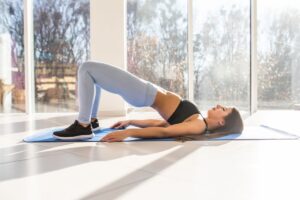Strength training, posture correction, and injury prevention all depend on back workouts. Exercise is frequently recommended as a treatment for persistent low back pain because it has been shown to enhance function and productivity. They can be broadly divided into workouts that focus on the upper, middle, and lower back. These exercises include pull-ups, rows, extensions, and stretches. To target diverse muscle groups and movement patterns, a well-rounded back workout should include a range of these exercises. This article’s objective is to discuss a number of important exercise-related topics.
Each back exercise is performed in three sets of ten to twelve repetitions, and a back workout can be divided into upper, middle, or lower back exercises. Dumbbells and body weight can be used for back exercises at home, or you can use gym equipment like cable or lever machines.
Here are a few exercises to incorporate into back workout:
1) pull-down cable lat
2) Barbell row in an upright position
3) Pullover of cables
4) Chin-up
5) Back Extension
6) Deadlift
7) Pendlay row
8) bent-over row
9) Superman
10) Inverted Row
What is the famous back exercise over the world:
According to Dr. Porcari, the best exercise is the bent-over row. The bent-over row is a weighted exercise that is mostly used to strengthen the shoulders, arms, and back. It involves bending at the hips and knees and maintaining an upright back while bringing a weight—a dumbbell or barbell—into the body. This exercise is commonly included in bodybuilding and powerlifting regimens.
Bolsters the back and arms: Bent-over rows are an excellent way to increase muscle mass and strength in the upper body.
Improves posture: One can improve posture and mitigate the detrimental effects of prolonged sitting by strengthening the back muscles.
Strengthens and stabilises the core: To maintain proper form and balance, the exercise requires core activation.
What is more suitable back exercise:
The two finest back workouts are pull-ups and deadlifts. By strengthening the complete posterior chain, deadlifts enhance functional strength and posture. Pull-ups improve general back development by working the upper back, lats, and grip.
King of all back exercises:
A difficult upper body workout, the pull-up involves raising your body weight by pushing yourself up on a bar, usually using an overhand hold. The main muscles worked by this complex movement are the latissimus dorsi, trapezius, and biceps brachii. Strengthening, correcting posture, and improving general upper body fitness can all be achieved with pullups.
Benefits:
Children’s back workouts should include fun, age-appropriate activities that emphasize posture correction and core development. The plank, shoulder blade squeezes, and the cowcat stretch are a few examples. The plank is a popular exercise for strengthening the back and abdominal muscles, and even 6-year-olds may learn how to perform it. Always put good form and supervision first, especially while performing more difficult activities.
Young folks and seniors alike can benefit from back workouts. Back exercises can be customized to meet the requirements and skills of each individual; there is no set age range for doing them exclusively. For example, older adults may prioritize pain treatment and mobility maintenance, while younger people may prioritize strength training and prevention of future problems.
Exercises for the back are best performed first thing in the morning. The exercises will help you relax and awaken the muscles that support your spine, which can help your back become less stiff after spending the entire night in bed. We also have a quick back workout that you can complete in under five minutes.
In order to strengthen and stretch the back muscles, doctors frequently recommend exercises like the modified cobra, standing hip stretch, sitting spinal twist, pelvic tilts, or glute bridges. To strengthen the back, certain exercises like the bent-over row, pull-ups, and deadlifts are advised, particularly for people who are already physically active. Walking, cycling, and swimming are examples of low-impact aerobic workouts that can help with back discomfort.
Best time to start Back Exercises:
The best time to start is when one can incorporate back exercises into their schedule on a regular basis.Even while some studies suggests that morning workouts may be the greatest for consistency and overall fitness, it is important to find a time that works schedule and preferences.
Things to think about while determining the ideal time:
Individual Preference: Back exercises can provide you a sense of success and a great start to the day if you’re a morning person. It’s also quite OK if nights are more convenient for you.
Consistency: Establishing a time that you can consistently adhere to is crucial.
Circadian Rhythm: Some people discover that they function better physically at particular times of the day. Observe your body’s natural cycles and modify your exercise regimen accordingly.
Particular Objectives: Studies suggest that afternoon exercises may be somewhat more advantageous if your objective is to gain muscle. It can be more beneficial to work out between 7 and 9 am if you are trying to lose weight.
Advantages of strong back:
The muscles in the back provide the body power, which is essential for all bodily activities. The neck, shoulder, chest, butt, and hips are all connected by them. It is a connection between the main muscles of the human body. It should be our duty to strengthen our back muscles rather than a pleasure. Exercises for the back are essential for general health since they increase strength, enhance posture, and lower the chance of discomfort. A fitness program that includes a range of back exercises, such as strengthening and flexibility routines, can promote long-term musculoskeletal health. Fortunately, strengthening the muscles in the back can help you improve your posture. Back muscle exercise may also assist you avoid injuries and back pain. The muscles that surround your spine, like other muscles, can weaken with age or lack of activity, increasing your risk of injury and discomfort.
One of the safest and most efficient methods to improve health and fitness is via exercise. For instance, physical activity can reduce blood sugar, cholesterol, and fat levels, build muscles, avoid falls, boost mood, and strengthen the cardiovascular system. Poor posture can result from weak core muscles as well as repetitive everyday tasks like staring down at your phone or typing on your computer. Postural issues may be resolved, thankfully, by strengthening your back muscles. Additionally, back muscle exercise may help prevent back discomfort and injuries. improves the healing process and lessens stiffness that causes back pain by increasing blood flow and nutrients to the soft tissues of the back. A stronger back, better posture, and a lower chance of discomfort are just a few advantages of back workouts, which are essential for general health and wellbeing. Frequent exercises for the back that include both strengthening and flexibility help improve functional mobility and maintain a healthy musculoskeletal system. A healthy back ultimately leads to a more active and painfree existence.
Numerous advantages come with doing back exercises at home, such as better posture, increased flexibility, strengthened core muscles, and pain prevention and alleviation. By encouraging a strong, balanced body and a healthy back, they help improve general wellbeing. One of the best methods to lower tension, lessen discomfort, and enhance general wellbeing is to have a back massage. There are several advantages to doing back exercises in the gym, such as better posture, less back discomfort, more strength, and an overall increase in fitness. Good posture, back pain relief, and injury prevention are all made possible by strong back muscles, which also support the spine and make daily tasks simpler. A strong back is essential to overall health for a variety of reasons, including pain reduction, increased sports performance, injury prevention, and better posture. The several specialized muscles that make up your back allow you to move your body in a variety of ways, including twisting, turning, bending, standing, walking, running, and lifting. You can accomplish daily tasks like putting on your shoes or shutting a window more easily if you strengthen your back muscles. Additionally, having strong back muscles can improve physical performance in sports like climbing and swimming. Back discomfort may be lessened by riding, swimming, and walking. Begin with brief sessions and gradually increase. Try swimming, where the water supports your body, if your back hurts. Do not use any strokes that cause your body to twist. Pilates incorporates core abdominal, strengthening, and stretching movements. In reaction to physical inactivity, skeletal muscles undergo adaptive reductive remodelling. This causes muscle mass loss and changes in muscle composition, resulting in a reduction in muscular strength (sarcopenia). The paraspinal muscles (erector spinae, transversospinalis, and abdominal muscles alter in reaction to physical inactivity, resulting in atrophy and increased fat content, raising the risk of low back discomfort. Following an evaluation of back function, we developed a therapy plan. This involves recommending precise and gradual strength workouts. Physiotherapists use exercise to strengthen the strength of the damaged and surrounding regions by enhancing the trunk’s tolerance and ability to bear load and control movement.




